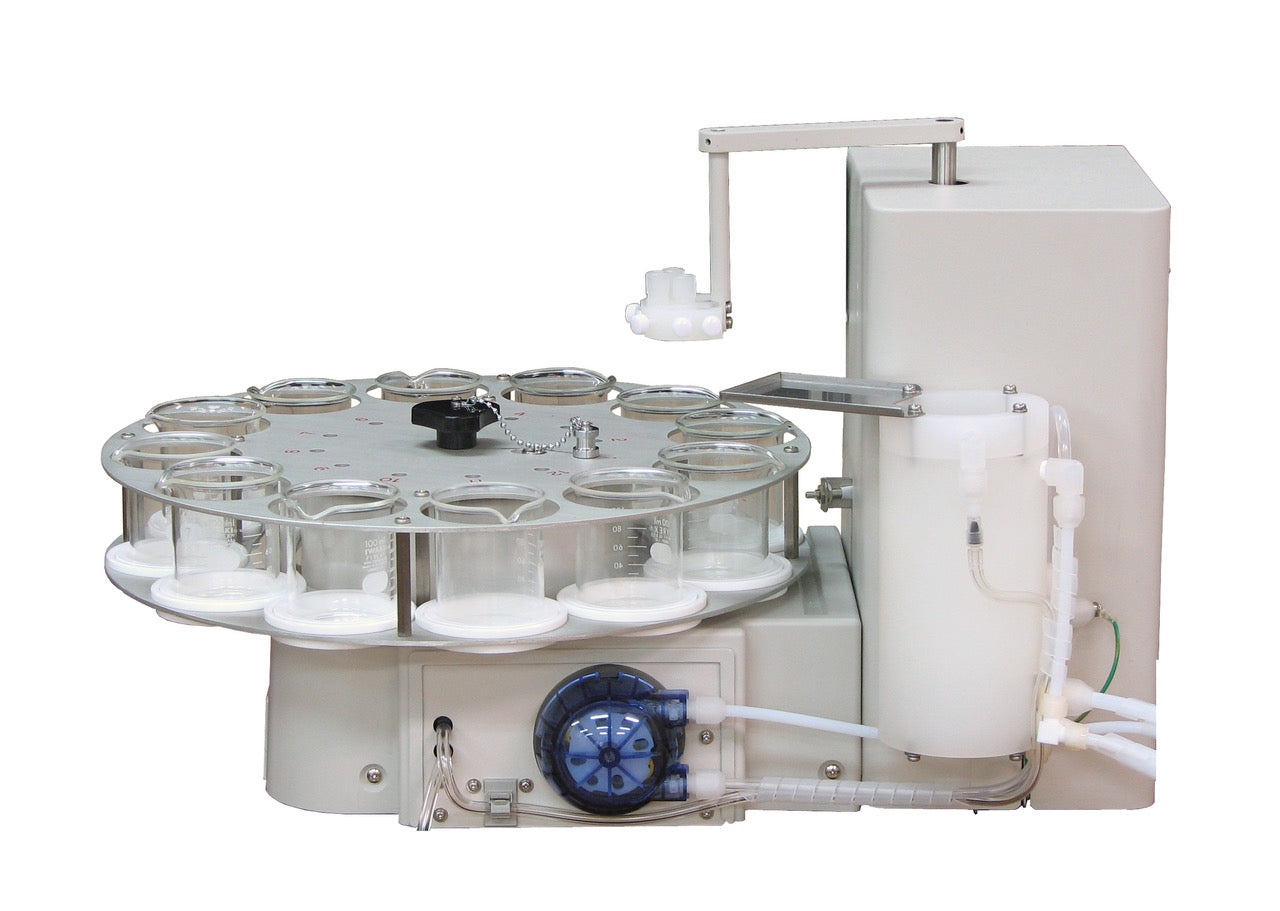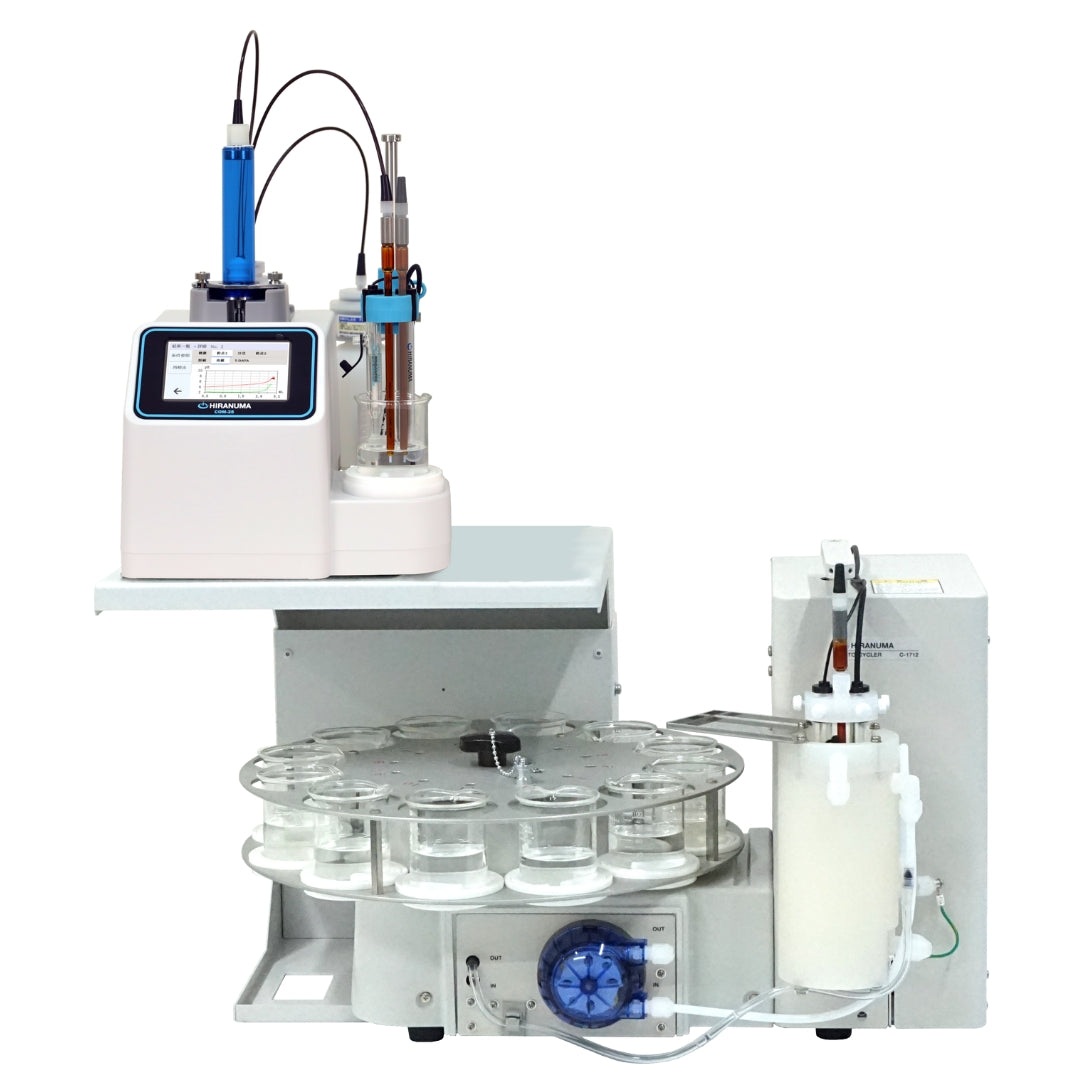| HIRANUMA APPLICATION DATA | Automatic Titrator | Data No. | B19 | Apr. 19,2018 |
| Drugs and Medicines | Purity determination for papaverine hydrochloride by perchloric aid titration |
1. Abstract
Determination for papaverine hydrochloride is defined in Japanese Pharmacopoeia. Papaverine hydrochloride is used for improvement of vasodilatation and symptoms on gastritis, disease of biliary tract (gallbladder) system, acute arterial embolus, acute pulmonary embolism, peripheral circulatory failure, and inadequate coronary circulation.
The purity determination of papaverine hydrochloride using potentiometric titration with perchloric acid titrant is introduced in this report. Sample is dissolved by heating with acetic anhydride / glacial acetic acid mixture and cooled to room temperature. After that, the titration is performed, 1 mol papaverine hydrochloride reacts with 1 mol perchloric acid quantitatively.

Papaverine hydrochloride (C₂₀H₂₁NO₄・HCl, FW:375.85)
2. Configuration of instruments and Reagents
| (1) | Configuration of instruments | ||
| Main unit | : | Hiranuma Automatic Titrator COM Series | |
| Electrodes | : | Glass electrode GE-101B | |
| : | Reference electrode RE-201Z Inner solution has to be changed to saturated sodium perchlorate in glacial acetic acid. |
||
| (2) | Reagents | ||
| Titrant | : | 0.1 mol/L perchloric acid – acetic acid standard solution | |
| Titration solvent | : | Mixture of glacial acetic acid and acetic anhydride (3:7, v/v) | |
| Inner solution | : | Saturated sodium perchlorate in glacial acetic acid | |
3. Measurement procedure
| (1) | Take about 0.5 g of sample into 200 mL beaker and weigh accurately to 0.1 mg digits. |
| (2) | Add 100 mL of titration solvent and dissolve sample by heating and stirring. After that, cool it down to room temperature. |
| (3) | Immerse the electrode and titrate by 0.1 mol/L Perchloric acid – acetic acid standard solution. Additionally, perform the blank test with the same procedure of sample measurement. |
4. Measurement conditions and results
Examples of titration conditions
Measurement of blank

Measurement of sample
Measurement results
Measurement of blank
| Number of Measurement |
Size (g) |
Titrant volume (mL) |
|---|---|---|
| 1 | – | 0.010 |
| 2 | – | 0.010 |
| Avg. (Blank) |
0.010 mL | |
Measurement of sample
| Number of Measurement |
Size (g) |
Titrant volume (mL) |
Purity (%) |
|---|---|---|---|
| 1 | 0.4593 | 12.216 | 100.0830 |
| 2 | 0.4815 | 12.761 | 99.7310 |
| 3 | 0.4746 | 12.595 | 99.8637 |
| Statistic calculation |
Avg. SD RSD |
99.89 % 0.18 % 0.18 % |
|
Examples of measurement curves
|
|
|
5. Note
| (1) | Temperature correction of perchloric acid standard solution This measurement determines the purity of the sample. Therefore, please pay attention for accurate weighing, measurement of factor or blank. Especially, the factor determination of perchloric acid – acetic acid standard solution should be regularly performed with potassium hydrogen phthalate. Acetic acid used as a solvent for the titrant has a relatively large thermal expansion coefficient. For example, a temperature change of 1 °C on this titrant causes a volume change of 0.1 %. Factor titration and sample measurement should be performed at the same room temperature as much as possible for accurate measurement. When the temperature of the sample measurement is different from that of factor titration, assign the following correction formula for titrant factor to the concentration calculation of sample.
|
||||||||
| (2) | Preparation of inner solution for reference electrode The inner solution of the reference electrode RE-201Z is filled with saturated KCl aqueous solution when purchased. This inner solution have to be replaced to saturated sodium perchlorate in acetic acid solution for this measurement. Replacement procedure is described below.
|
| Keywords: | Drug, Papaverine hydrochloride, Japanese pharmacopoeia, Perchloric acid titration, Non-aqueous titration, Saturated sodium perchloric acid – acetic acid solution |
*Some measurement would not be possible depending on optional configuration of system.











